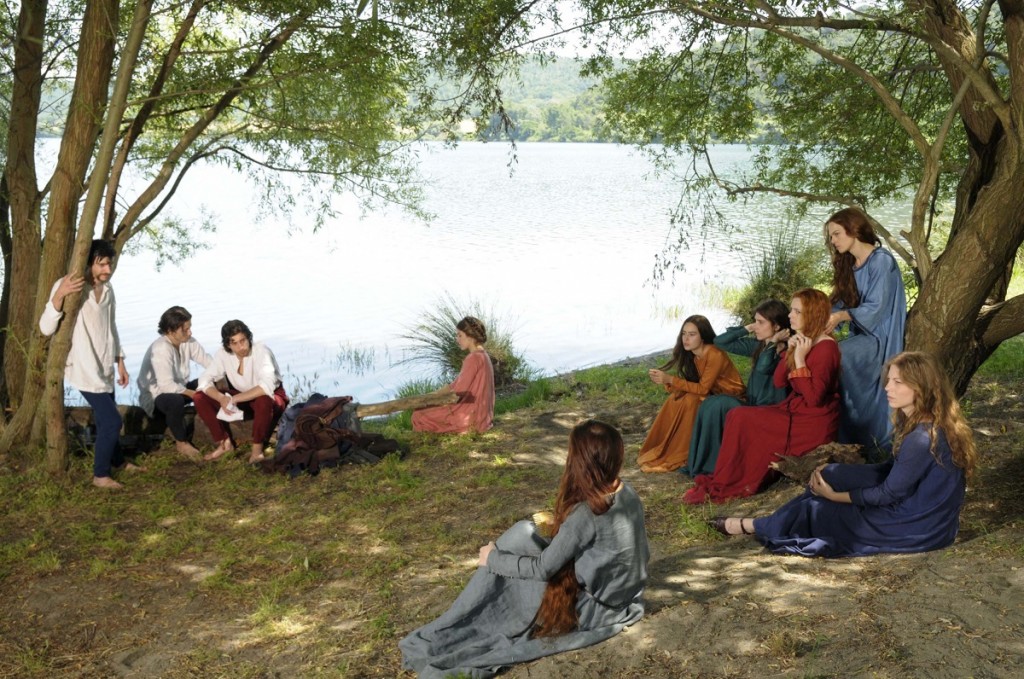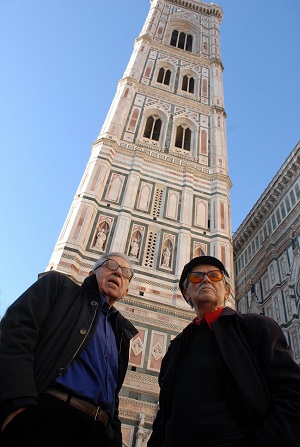Tribeca Interviews: Paolo Taviani Discusses ‘Wondrous Boccaccio,’ Life, Love, and the Plague

A scene from ” Wondrous Boccaccio.” Photo: Simone Zampagni/Umberto Montiroli.
A man stands on a precipice. He is framed by a dull sky, seen from behind and below. Though the shot is close up on him, the height of the ledge and his intention are clear enough from the look of fear in his eyes as he glances over his shoulder. He turns toward the viewer, his disheveled shirt left open only to reveal putrid splotches on his neck and chest. He has the plague. Covering his face with the crook of his elbow, he leaps to his death.
So begins Maraviglioso Boccaccio (Wondrous Boccaccio), the latest film from directors Paolo and Vittorio Taviani, the celebrated brothers of Italian cinema. Riding high on the success of their last film, Caesar Must Die — an interpretation of Shakespeare’s Julius Caesar that won the prestigious Golden Bear award at the 62nd Berlin International Film Festival — the Tavianis embark once more into the Western literary canon, this time taking inspiration from Giovanni Boccaccio’s Decameron. After an Italian premiere in February, the film recently showed at the Tribeca Film Festival, with one half of the directorial duo, Paolo, in attendance.
Like the 14th century text on which it’s based, the film is set in the countryside near Florence, where seven young women and three young men take refuge from the horrors of the Black Death raging in the city. This frame narrative gives way to several stories, which the refugees tell to pass the time and keep their spirits up. Forgoing the overwhelming 100 novellas from the original work, the Tavianis instead focus on five stories, dipping in and out of layered tales that investigate the human condition. The protagonists hope these stories will distract them from their cruel situation, but their tales instead yield visceral reactions. Accounts of crude trickery receive shocked scorn from the listeners. Fables of lost love bring tears. Sagas of triumphant love earn compliments and faith that love will conquer chaos — the faith of the young refugees and of the viewer.
The filmmakers eschew straight adaptation for a more creative interpretation, producing a film that engages the eternal roles of art in the face of death. With the vivid Tuscan countryside as a backdrop, the Tavianis employ striking color schemes and painterly composition to evoke Renaissance art, especially the frescoes of Giotto. Meanwhile, the grand musical overtures reinforce the heavy themes underlying the tales. Ultimately, the directors wish their film to stand symbiotically with its literary inspiration, at once evoking the intellectual weight of Boccaccio while addressing modern life.
GALO sat down with the 83-year-old Paolo at the Tribeca Film Festival to discuss plagues, the Western canon, Pier Paolo Pasolini’s The Decameron (1971), and the role of art in times of horror.
Editorial Note: This interview was translated from Italian by an on-site translator.
GALO: How does this film play differently to an American audience at Tribeca than it did during its Italian premiere in February, where there is a connection of heritage to Boccaccio’s original work?
Paolo Taviani: What do you think?
GALO: Well, I feel there is certainly a similar connection to the Western literary canon in America, but the Italian countryside and the film’s setting might strike Americans in a different way. Certainly the setting seems idyllic, but I’m not sure there is quite the same connection to heritage that the source material of Boccaccio might impart on an Italian audience.
PT: The connection between Italians and their heritage is not as strong as you might think. I don’t believe it is so strong as to determine the success or failure of a film.
Our biggest successes in the United States — which is always a relative success — have so far been with Padre Padrone (Father and Master, 1977), La Notte di San Lorenzo (The Night of the Shooting Stars, 1982), and Caesar [Caesar Must Die]. These films were very much loved here in the United States. But I think the very fact of showing a film with subtitles tends to alienate the audience a little bit. They might sort of reject it. On the other hand, to dub a film would be a waste of time because it immediately would come across as false.
So the success of our films here is always a relative success. I think the same is true of French films and films from various parts of the world. We have in the past, and lately, always found this great love toward our films.
GALO: You mentioned Caesar Must Die (Cesare deve morire). That film is very much bound by the prison walls of Rebibbia. Did you feel at all claustrophobic coming out of that film and thus wanting to do a more rural one for your next project?
PT: That’s not really the case, but I would say there is a similarity between the two films that’s maybe not immediately noticeable. In Caesar, [which was] shot inside the prison, we are dealing with prisoners who have life sentences and an everyday life of pain and suffering. But through art, Shakespeare and this play, for a few hours, they experience what it means to be alive. They can overcome the horrors of their everyday life and survive what they are going through.
In the case of Boccaccio, these young people are escaping the horrors of the plague. They escape from the city into the countryside. And through art and storytelling, they are able to overcome death and suffering momentarily, after which they must return to Florence, where the plague is still raging.
But as the prisoners return to their cells, they return a little bit stronger from the experience that they have had. And the young people in Boccaccio, when they return to Florence, they return also strengthened by the bonds formed through storytelling.

L-R: Paolo and Vittorio Taviani. Photo: Umberto Montiroli.
GALO: That’s a very hopeful interpretation, or adaptation, of Boccaccio. Where does this film stand in the tradition of adaptations of the Decameron?
PT: I think that the only other film based on The Decameron worth discussing is Pasolini’s film [of the same name]. When he made it, he focused on one aspect of the novellas, which was the Neapolitan side. Boccaccio grew up at the court of Naples. So Pasolini focuses a lot on the dialogue of Naples. The stories take place in the area of Naples. We instead focused on the Tuscan side of the country and on Boccaccio.
Pasolini was very focused on the human body — bodies coming together and pulling apart. There was a great physicality in his version of The Decameron. And this aspect coincides very much with the period in which that film was made [1971]. Pasolini was battling with the laws against sexual freedom and battling the censors throughout his life. That informs the way in which the film was made. Ours is made many years later, and it is a child of the history of today instead, which is very distant from the times in which Pasolini made his film.
On the other hand, when you make a film based on a literary text, there are a thousand different ways that you could go. We did not set out to illustrate The Decameron, nor did Pasolini. We set out to talk about our feelings. We used these stories as a starting point. We looked at Boccaccio (as did Pasolini) as having written a great treatment — something that inspired us to then take very different roads. For that matter, however, anyone living in the present betrays their origins. They take something that inspires them and they make it into something else.
GALO: You mention that these stories are a way to talk about our life. Do you think the episodic form specifically reflects our modern reality, or does it reveal something normally hidden in everyday life?
PT: That’s really up for you to decide as the critic. But you used an expression that I detest: “episodic film.” This is not an episodic film. I hope it’s not an episodic film.
[Laughter]
It’s because this is a film where we built a large frame, within which these stories move in and out naturally — [and] within which these young people can tell their stories. So it is not episodic, but it is what you would call in Latin unus or unified.
With regard to what is modern or contemporary about the film, I think it is the most contemporary of our films in the sadness that it responds to. We decided to take up the story because of the word “plague.” None of the other film adaptations of The Decameron have talked about the plague, but the plague is the driver of the frame story in which these other stories are told.
Vittorio and I were talking, and the word “plague” kept recurring in our conversations about what is happening in the world today. I received a phone call from Rome just now. I learned that another 200 migrants died after their boat capsized in the terrible tragedy of last week. [We discussed] what’s happening with ISIS, what’s happening in Africa, and what’s happening in Italy in maybe a more subterranean way with the unemployment that afflicts young people so disproportionately. So we decided to talk about the plague.
Plague in a way is the metaphor — though I don’t like the word “metaphor” because it is too literary, but it does seem like the appropriate word to use. The plague is the driver of Boccaccio. It is the driver of the film. It is what drives these young people to leave the city and to go into the open countryside, to look to art, and together to seek deliverance from this horror. Talking about these love stories is what gives them the strength to react to what’s happening. I asked the cinematographer [Simone] Zampagni to portray the Tuscan landscape in all of its violent beauty, the way the Renaissance painters did. This beauty is also something that helps us respond to the horror.
“The Wondrous Boccaccio” had its international premiere at the 2015 Tribeca Film Festival on April 20.
